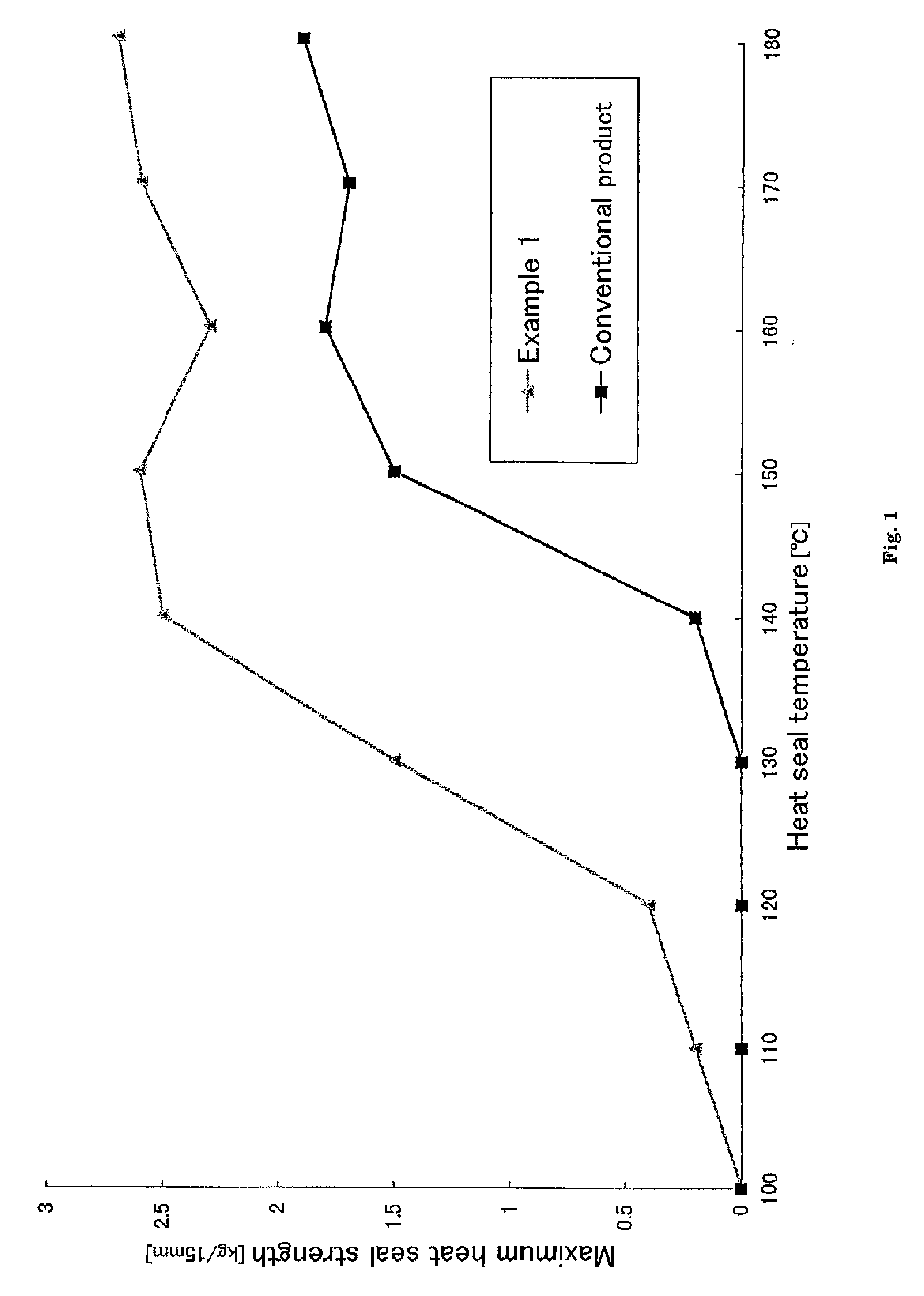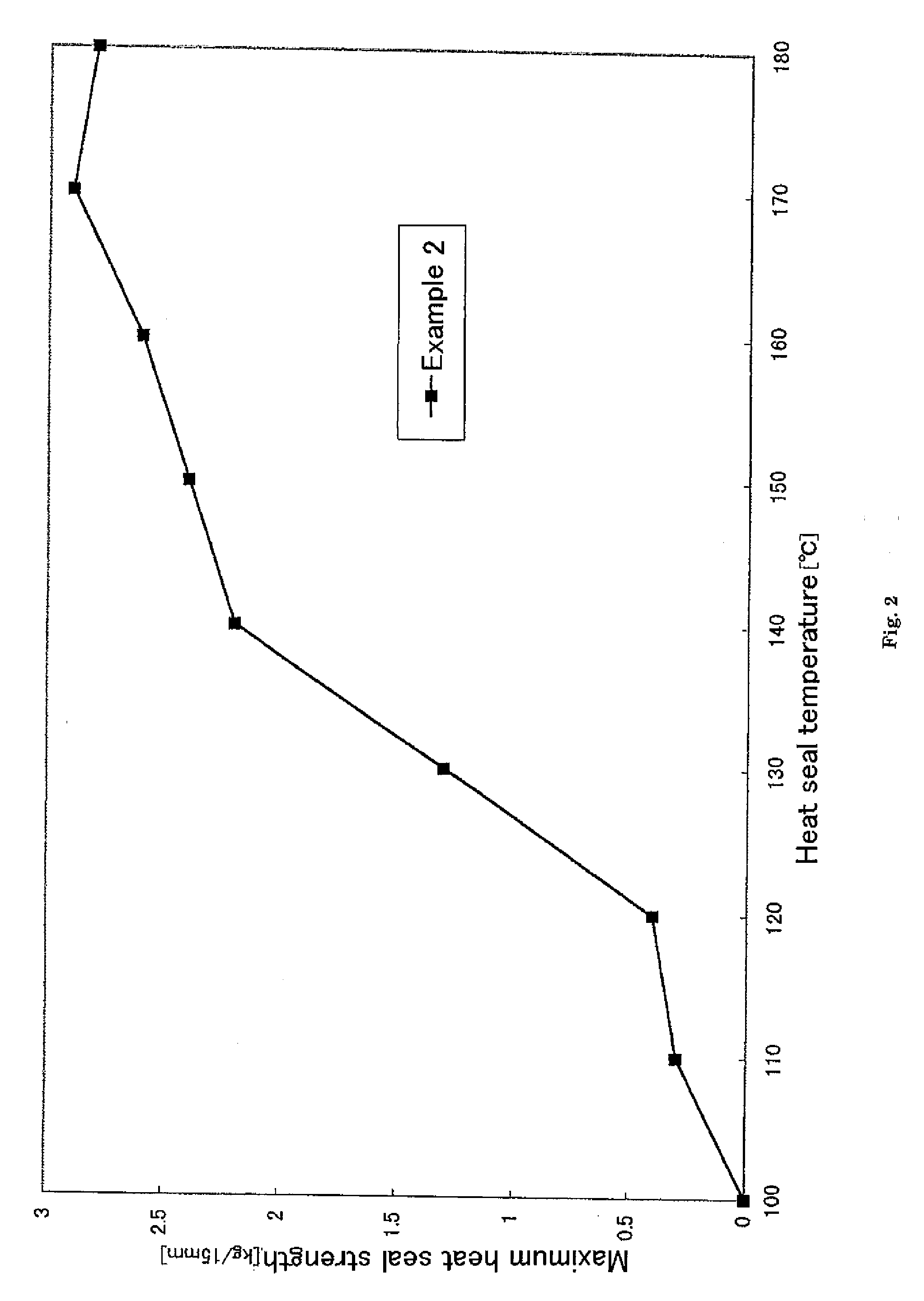Biodegradable Bags for Packing Foods Available in High Speed Production
a biodegradable bag and high-speed technology, applied in the field of biodegradable bags for food packing, can solve the problems of difficult heat transmission, deterioration of taste, extreme difficulty in recycling materials in packaging, etc., and achieve the effects of avoiding global environmental burden, enhancing adhesiveness between the respective layers, and avoiding deterioration
- Summary
- Abstract
- Description
- Claims
- Application Information
AI Technical Summary
Benefits of technology
Problems solved by technology
Method used
Image
Examples
example 1
[0097]A 15 μm aliphatic polyester resin polybutylene succinate (BIONOLLE #1001m, manufactured by SHOWA HIGHPOLYMER CO., LTD.) was dry-laminated using a biodegradable adhesive (mixture of several aliphatic polyester resins dissolved in methyl ethyl ketone) onto a thin paper with a basis weight of 20 g / m2 (about 20 μm in thickness) which had been laminated with a 10 μm biodegradable polylactic acid LACTY grade #9800 commercially available from SHIMADZU CORPORATION by means of a melt extrusion and which had then been vapor-deposited with Al2O3 on its polylactic acid side, whereby obtaining a film roll for a snack food bag.
[0098]The resultant film roll and a conventional film roll comprising OPP (18 μm) / PE (13 μm) / PET (12 μm) / Al vapor deposition (500 angstrom) / PE (13 μm) / CPP (20 μm) were examined for the heat seal temperature property, O2 permeability and H2O permeability, which were then compared. The results are shown in FIG. 1 and Table 1.
[0099]The measurement of the O2 permeability ...
example 2
[0107]A 15 μm aliphatic polyester resin polybutylene succinate (BIONOLLE #1001m, manufactured by SHOWA HIGHPOLYMER CO., LTD., melting point: 114° C.) was laminated using a biodegradable adhesive employed in EXAMPLE 1 with a thin paper with a basis weight of 20 g / m2 (about 20 μm in thickness) which had been laminated using a biodegradable adhesive employed in EXAMPLE 1 with a biaxial oriented (20 μm in thickness) LACTY #9000 (melting point of 150 to 170° C.) from SHIMADZU CORPORATION with its biaxial oriented film side being subjected to a vapor deposition with SiO1.8, whereby obtaining a film roll for a snack food bag.
[0108]The resultant film roll was examined for the heat seal temperature property, O2 permeability and H2O permeability. The results are shown in FIG. 2 and Table 3.
TABLE 3Evaluation itemH2OO2 permeabilitypermeability(ml / m2 · D · Atm)(g / m2 · D)Film rollProduct of the invention1.82.0
[0109]The heat seal temperature property shown in FIG. 2 appeared as a curve which was a...
example 3
[0111]The surface of the paper of the roll film of the present invention obtained in EXAMPLE 1 was printed with a soybean ink manufactured by TOYO INK MFG. CO., LTD. which is a biodegradable ink.
[0112]A piece of this roll film was buried in the soil to be subjected to the biodegradability test similarly to EXAMPLE 1, and the results indicated a satisfactory biodegradability.
PUM
| Property | Measurement | Unit |
|---|---|---|
| melting point | aaaaa | aaaaa |
| melting point | aaaaa | aaaaa |
| thickness | aaaaa | aaaaa |
Abstract
Description
Claims
Application Information
 Login to View More
Login to View More - R&D
- Intellectual Property
- Life Sciences
- Materials
- Tech Scout
- Unparalleled Data Quality
- Higher Quality Content
- 60% Fewer Hallucinations
Browse by: Latest US Patents, China's latest patents, Technical Efficacy Thesaurus, Application Domain, Technology Topic, Popular Technical Reports.
© 2025 PatSnap. All rights reserved.Legal|Privacy policy|Modern Slavery Act Transparency Statement|Sitemap|About US| Contact US: help@patsnap.com



